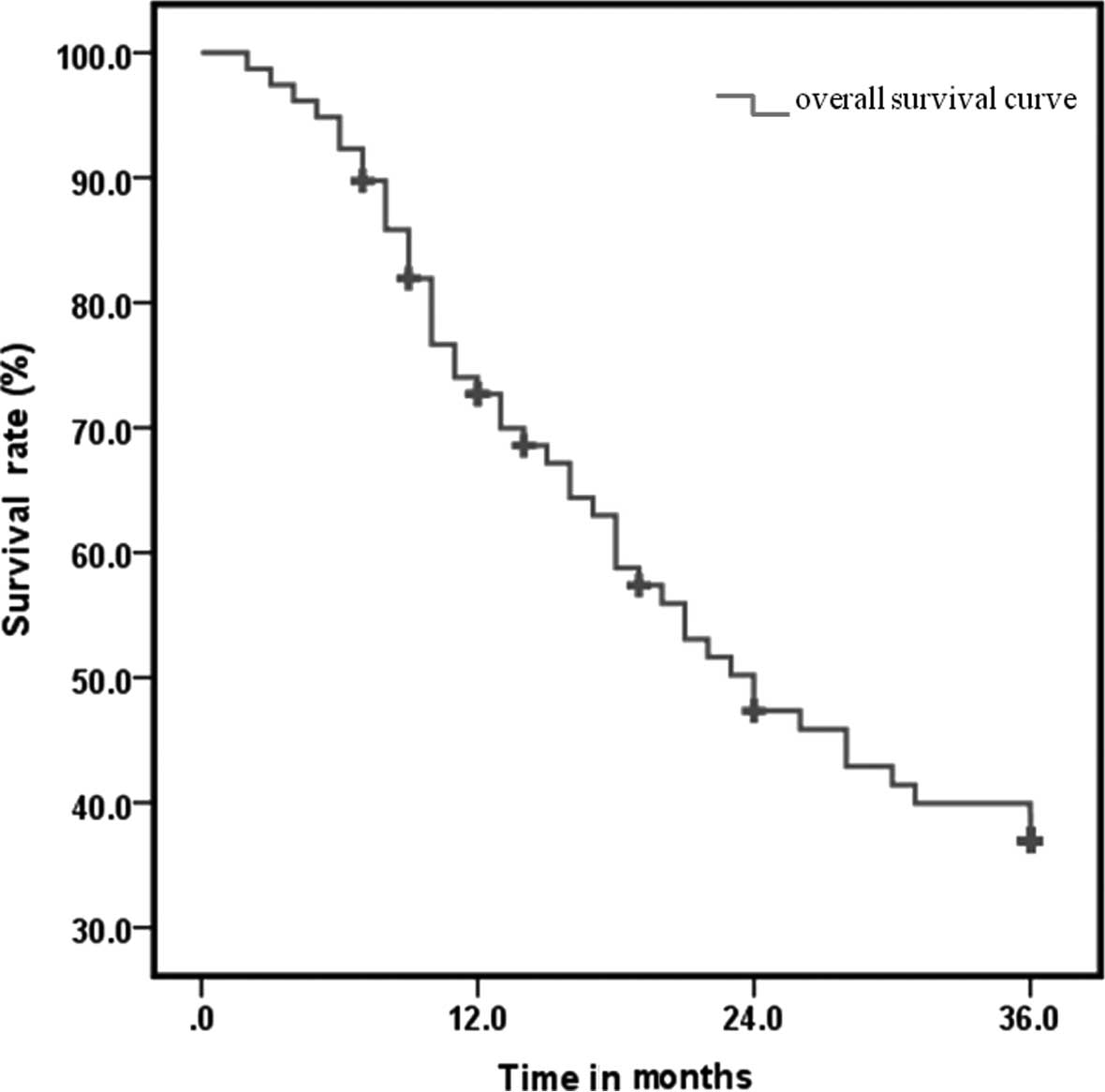Clinical experience with radio-, chemo- and hyperthermotherapy combined trimodality on locally advanced esophageal cancer
- Authors:
- Haiwen Zhu
- Xudong Huo
- Longyun Chen
- Hanhua Wang
- Hongliang Yu
-
View Affiliations
Affiliations: Department of Radiation Oncology, Yancheng Third People's Hospital, Yancheng, Jiangsu 224000, P.R. China, Department of Radiation Oncology, Jiangsu Cancer Hospital, Nanjing, Jiangsu 210000, P.R. China
- Published online on: July 26, 2013 https://doi.org/10.3892/mco.2013.161
-
Pages:
1009-1012
Metrics:
Total
Views: 0 (Spandidos Publications: | PMC Statistics:
)
Metrics:
Total PDF Downloads: 0 (Spandidos Publications: | PMC Statistics:
)
This article is mentioned in:
Abstract
Esophageal cancer is a highly malignant and lethal disease with a low 5-year survival rate. Therefore, an effective treatment modality is required. To investigate the treatment efficacy and toxicity of radio-, chemo- and hyperthermotherapy combined trimodality on locally advanced esophageal cancer, the medical records of 78 patients with pathologically confirmed esophageal cancer treated with chemoradiotherapy plus hyperthemia at our institution were retrospectively investigated and the 3‑year outcome was carefully assessed. All 78 patients received intensity‑modulated radiation therapy at a total dose of 60-66 Gy, in a conventional schedule of 1.8-2.1 Gy/fraction, 5 fractions/week. They also received 4-6 courses of chemotherapy, consisting of 450 mg/m2 5‑fluorouracil for 1‑5 days and 25 mg/m2 cisplatin for 1‑5 days, in addition to 6-12 sessions of hyperthermia, performed twice a week. Out of the 78 cases, complete remission of the primary tumor was observed in 31 (39.7%), partial remission in 44 (56.4%) and no change in 3 (3.9%) cases. The treatment response rate was 96.1%. The overall survival (OS) rate at 1, 2 and 3 years was 67.9, 41.0 and 33.3%, respectively. No significant difference in adverse effects was observed between this treatment regimen and other similar studies. Our preliminary results demonstrated that the chemo-, radio- and hyperthermotherapy combined trimodality exhibited excellent short‑term clinical outcomes as regards tumor response rate and a sound long‑term OS, with endurable adverse events. This trimodal treatment requires further investigation to establish its beneficial role in the treatment of patients with locally advanced esophageal cancer.
View References
|
1.
|
Jemal A, Center MM, DeSantis C and Ward
EM: Global patterns of cancer incidence and mortality rates and
trends. Cancer Epidemiol Biomarkers Prev. 19:1893–1907. 2010.
View Article : Google Scholar : PubMed/NCBI
|
|
2.
|
Kleinberg L, Gibson MK and Forastiere AA:
Chemoradiotherapy for localized esophageal cancer: regimen
selection and molecular mechanisms of radiosensitization. Nat Clin
Pract Oncol. 4:282–294. 2007. View Article : Google Scholar : PubMed/NCBI
|
|
3.
|
Jemal A, Siegel R, Xu J and Ward E: Cancer
statistics. CA Cancer J Clin. 60:277–300. 2010.
|
|
4.
|
Cooper JS, Guo MD, Herskovic A, et al:
Chemoradiotherapy of locally advanced esophageal cancer: long-term
follow-up of a prospective randomized trial (RTOG 85-01). Radiation
Therapy Oncology Group JAMA. 281:1623–1627. 1999.PubMed/NCBI
|
|
5.
|
Wust P, Hildebrandt B, Sreenivasa G, et
al: Hyperthermia in combined treatment of cancer. Lancet Oncol.
3:487–497. 2002. View Article : Google Scholar : PubMed/NCBI
|
|
6.
|
Franckena M, Lutgens LC, Koper PC, et al:
Radiotherapy and hyperthermia for treatment of primary locally
advanced cervix cancer: results in 378 patients. Int J Radiat Oncol
Biol Phys. 73:242–250. 2009. View Article : Google Scholar : PubMed/NCBI
|
|
7.
|
Moyer HR and Delman KA: The role of
hyperthermia in optimizing tumor response to regional therapy. Int
J Hyperthermia. 24:251–261. 2008. View Article : Google Scholar : PubMed/NCBI
|
|
8.
|
Jones EL, Oleson JR, Prosnitz LR, et al:
Randomized trial of hyperthermia and radiation for superficial
tumors. J Clin Oncol. 23:3079–3085. 2005. View Article : Google Scholar : PubMed/NCBI
|
|
9.
|
Eisenhauer EA, Therasse P, Bogaerts J, et
al: New response evaluation criteria in solid tumours: revised
RECIST guideline (version 1.1). Eur J Cancer. 45:228–247. 2009.
View Article : Google Scholar
|
|
10.
|
Trotti A, Colevas AD, Setser A, et al:
CTCAE v3.0: development of a comprehensive grading system for the
adverse effects of cancer treatment. Semin Radiat Oncol.
13:176–181. 2003. View Article : Google Scholar
|
|
11.
|
Dinse GE and Lagakos SW: Nonparametric
estimation of lifetime and disease onset distributions from
incomplete observations. Biometrics. 38:921–932. 1982. View Article : Google Scholar : PubMed/NCBI
|
|
12.
|
Minsky BD, Pajak TF, Ginsberg RJ, et al:
INT 0123 (Radiation Therapy Oncology Group 94-05) phase III trial
of combined-modality therapy for esophageal cancer: high-dose
versus standard-dose radiation therapy. J Clin Oncol. 20:1167–1174.
2002. View Article : Google Scholar : PubMed/NCBI
|
|
13.
|
Zhang Z, Liao Z, Jin J, et al:
Dose-response relationship in locoregional control for patients
with stage II–III esophageal cancer treated with concurrent
chemotherapy and radiotherapy. Int J Radiat Oncol Biol Phys.
61:656–664. 2005.
|
|
14.
|
Galvin JM, Ezzell G, Eisbrauch A, et al:
Implementing IMRT in clinical practice: a joint document of the
American Society for Therapeutic Radiology and Oncology and the
American Association of Physicists in Medicine. Int J Radiat Oncol
Biol Phys. 58:1616–1634. 2004. View Article : Google Scholar : PubMed/NCBI
|
|
15.
|
Kitamura K, Kuwano H, Watanabe M, et al:
Prospective randomized study of hyperthermia combined with
chemoradiotherapy for esophageal carcinoma. J Surg Oncol. 60:55–58.
1995. View Article : Google Scholar : PubMed/NCBI
|
|
16.
|
Liu M, Shi X, Guo X, et al: Long-term
outcome of irradiation with or without chemotherapy for esophageal
squamous cell carcinoma: a final report on a prospective trial.
Radiat Oncol. 7:1422012. View Article : Google Scholar : PubMed/NCBI
|











